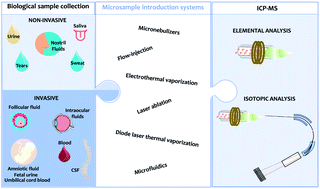Microsampling of biological fluids for elemental and isotopic analysis by ICP-MS: strategies and applications for disease diagnosis
Abstract
Human biological fluids are quite varied and complex. Some examples include blood, cerebrospinal fluid, synovial fluid, peritoneal fluid, intraocular fluids, and fluids that do not require an invasive sample uptake, such as lacrimal fluid, seminal fluid, sweat, urine and saliva. They are present in the body in very different volumes, from the low microliter level to the liter range. For those requiring invasive sampling, just a small percentage can be sampled in order not to disrupt the living body. Furthermore, quite often, the extracted samples must be divided into several aliquots required for different independent (bio)chemical assays. In addition, volumes of biofluids are much smaller in new-borns and infants. Therefore, just a microvolume of the biofluid is quite often available for analysis. Inductively coupled plasma-mass spectrometry (ICP-MS) is a suitable technique for elemental and isotopic determination of biological fluids at the trace and ultra-trace levels. Such determinations contributes to the interpretation of biochemical processes within our bodies and in many cases serve for the diagnosis of diseases. A research trend along the years has been to increase the capabilities of ICP-MS for the analysis of microsamples. This review focusses on strategies for microsample collection of fluids from the human body and their introduction into an ICP-MS. In addition, representative examples of applications in the clinical field are briefly described.

- This article is part of the themed collection: JAAS Review Articles 2022


 Please wait while we load your content...
Please wait while we load your content...